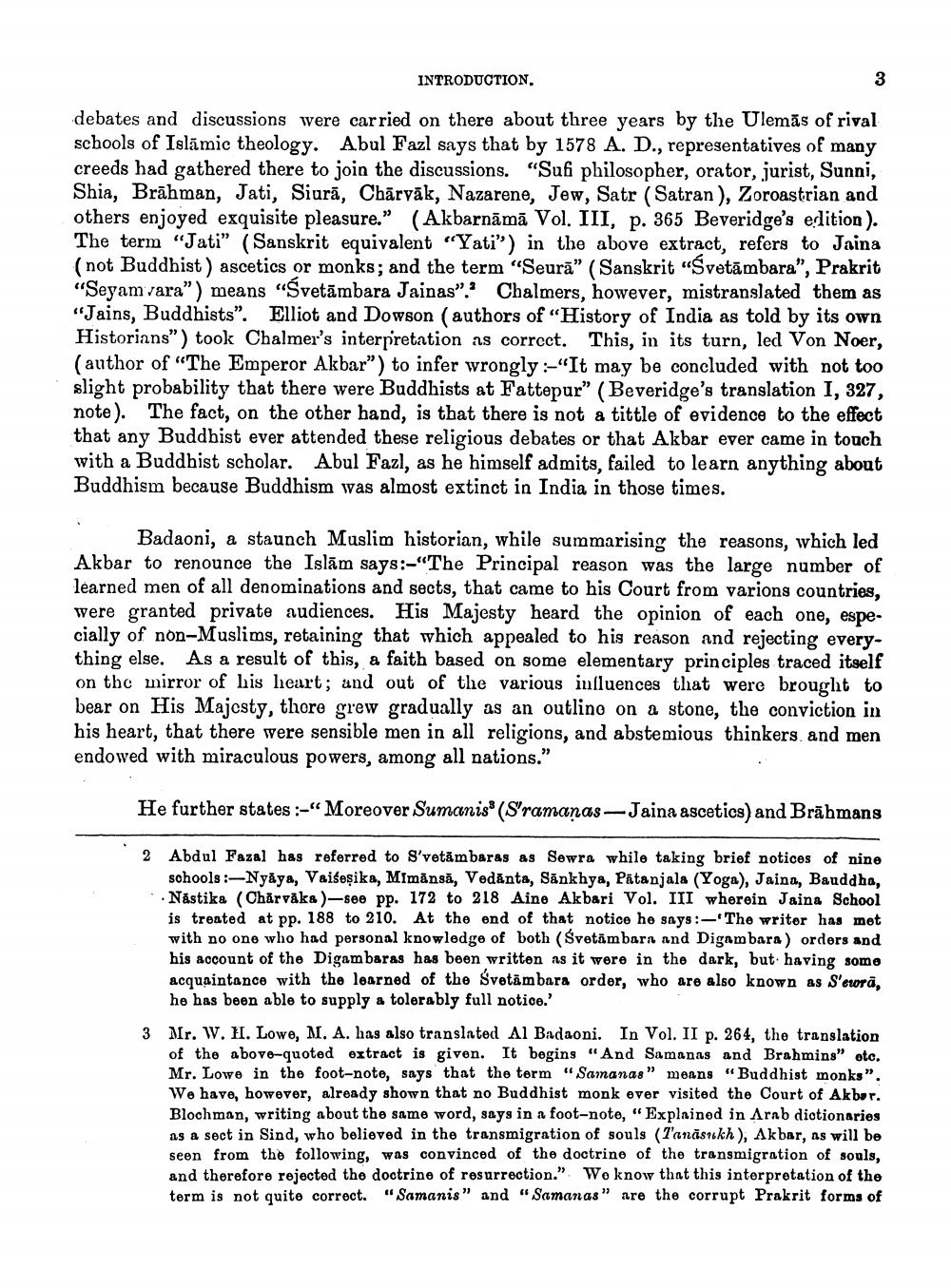________________
3
INTRODUCTION.
debates and discussions were carried on there about three years by the Ulemas of rival schools of Islamic theology. Abul Fazl says that by 1578 A. D., representatives of many creeds had gathered there to join the discussions. "Sufi philosopher, orator, jurist, Sunni, Shia, Brahman, Jati, Siură, Chärväk, Nazarene, Jew, Satr (Satran), Zoroastrian and others enjoyed exquisite pleasure." (Akbarnāmā Vol. III, p. 365 Beveridge's edition). The term "Jati" (Sanskrit equivalent "Yati") in the above extract, refers to Jaina (not Buddhist) ascetics or monks; and the term "Seura" (Sanskrit "Svetambara", Prakrit "Seyam vara") means "Svetambara Jainas". Chalmers, however, mistranslated them as "Jains, Buddhists". Elliot and Dowson (authors of "History of India as told by its own Historians") took Chalmer's interpretation as correct. This, in its turn, led Von Noer, (author of "The Emperor Akbar") to infer wrongly :-"It may be concluded with not too alight probability that there were Buddhists at Fattepur" (Beveridge's translation I, 327, note). The fact, on the other hand, is that there is not a tittle of evidence to the effect that any Buddhist ever attended these religious debates or that Akbar ever came in touch. with a Buddhist scholar. Abul Fazl, as he himself admits, failed to learn anything about Buddhism because Buddhism was almost extinct in India in those times.
Badaoni, a staunch Muslim historian, while summarising the reasons, which led Akbar to renounce the Islam says:-"The Principal reason was the large number of learned men of all denominations and sects, that came to his Court from various countries, were granted private audiences. His Majesty heard the opinion of each one, especially of non-Muslims, retaining that which appealed to his reason and rejecting everything else. As a result of this, a faith based on some elementary principles traced itself on the mirror of his heart; and out of the various influences that were brought to bear on His Majesty, thore grew gradually as an outline on a stone, the conviction in his heart, that there were sensible men in all religions, and abstemious thinkers and men endowed with miraculous powers, among all nations."
He further states:-" Moreover Sumanis (S'ramanas-Jaina ascetics) and Brahmans
2 Abdul Fazal has referred to S'vetämbaras as Sewra while taking brief notices of nine schools-Nyaya, Valdesika, Mimänsä, Vedants, Sankhys, Patanjala (Yoga), Jalna, Bauddha, Nästika (Chārvāka)-see pp. 172 to 218 Aine Akbari Vol. III wherein Jaina School is treated at pp. 188 to 210. At the end of that notice he says:-'The writer has met with no one who had personal knowledge of both (Svetambara and Digambara) orders and his account of the Digambaras has been written as it were in the dark, but having some acquaintance with the learned of the Svetambara order, who are also known as S'ewrā, he has been able to supply a tolerably full notice.'
3 Mr. W. H. Lowe, M. A. has also translated Al Badaoni. In Vol. II p. 264, the translation of the above-quoted extract is given. It begins "And Samanas and Brahmins" etc. Mr. Lowe in the foot-note, says that the term "Samanas" means "Buddhist monks". We have, however, already shown that no Buddhist monk ever visited the Court of Akbar. Blochman, writing about the same word, says in a foot-note, "Explained in Arab dictionaries as a sect in Sind, who believed in the transmigration of souls (Tanāsukh ), Akbar, as will be seen from the following, was convinced of the doctrine of the transmigration of souls, and therefore rejected the doctrine of resurrection." We know that this interpretation of the term is not quite correct. "Samanis" and "Samanas" are the corrupt Prakrit forms of




